Read STC’s Comments on the Leatherback Status Change Petition (pdf file).
Leatherback sea turtles are ancient, giant reptiles. Named for their unique shells composed of thin rubbery skin, they can dive the deepest and travel the furthest among all seven sea turtle species on earth. Leatherbacks have traveled the globe for millions of years, but they face a number of mostly human-caused threats to their survival and recovery.

A leatherback sea turtle returns to the sea after nesting. Photo credit: Karla Morales
One of the greatest threats they face is being accidentally caught by commercial fishing operations. When they are caught underwater in nets or on baited lines, they drown if they can’t reach the surface for air. They can also sustain internal injuries from hooks or external injuries from entanglement, including strangulation or amputation. In October of last year, a New Jersey-based organization representing commercial fishing interests quietly introduced a federal petition to classify the Northwestern Atlantic leatherback population as a distinct population and to change the status of this population under the Endangered Species Act from “endangered” to “threatened.”
In the petition, the group states that the Northwestern Atlantic leatherback population (including leatherbacks that nest in Florida, Costa Rica, and Panama) should be listed as “threatened” because it is “not currently at risk of extinction (i.e., endangered) due to its overall population size.” But the scientific evidence submitted with the petition did not take into account data from 2014 and forward that disputes this claim.
In Florida, leatherback nesting has decreased from 650 to just 200 nests since 2014, according to the Florida Fish and Wildlife Conservation Commission. In addition, over the last two decades, STC has documented a severe decline in leatherback nesting at Tortuguero, Costa Rica (see Figure 1). Furthermore, the nesting trend for this species at Chiriqui Beach, Panama, which had shown positive growth over a decade ago, actually shows a slight decline since 2005.
The future of leatherback sea turtles is also at risk due to climate change and global warming. Following a global trend, south Florida sea turtle hatchlings are becoming increasingly female due to warmer-than-average sand temperatures. Hot sand is also causing turtle embryos to overheat in their nests at STC’s research sites in Panama, reducing the hatching success rate to less than 20 percent in many areas monitored by STC.

Figure 1: STC has documented a severe decline in leatherback nesting at Tortuguero, Costa Rica.
If this population of leatherback sea turtles is downgraded to “threatened,” STC worries that commercial fisheries and other industries will take less care in reducing incidental “take,” or the accidental killing of leatherback sea turtles, and federal authorities will be less focused on the urgency with which this species needs protection.
NOAA is accepting public comment on this petition. STC will be making formal comments based on our own scientific data; however, anyone interested in sharing their opinion on the topic may do so online by visiting this site: https://www.regulations.gov/document?D=NOAA-NMFS-2017-0147-0001. We hope STC members will ask the federal government to reject this petition and keep leatherback sea turtles listed as “endangered” so they benefit from full protection under the Endangered Species Act.
**This workshop is not open to SERSTM registrants, only members of the general public.**
Join us for a special free workshop that’s open solely to the general public! It will engage citizens and share with them ideas on how they can become active participants in sea turtle conservation. They will listen to speakers from several organizations and learn ways to lend a hand and have a voice. Participants will be provided educational materials and swag bags. This workshop will be run from 9 am – 12 noon on Tuesday, February 13, 2018. For more information or to RSVP for this free workshop, please contact Rebecca Mott at rmott@inwater.org and check out the official SERSTM WORKSHOP FLYER.
 We want to be able to give people the tools to participate in conservation in their daily lives. The topics we will be tackling are:
We want to be able to give people the tools to participate in conservation in their daily lives. The topics we will be tackling are:
Marine Debris (Ocean Conservancy)- how to track trash on the mobile app
Turtle-friendly Lighting (Sea Turtle Conservancy)- how to create turtle-friendly lighting for your home
Local Nesting Work (Myrtle Beach State Park)- what nesting looks like on your local beach and how you can help
Sustainable Seafood (SC Aquarium)- how to choose wisely what goes on your plate
You can also get more information on the official Southeast Regional Sea Turtle Meeting (SERSTM) website www.serstm.org. Don’t forget to contact Rebecca Mott at rmott@inwater.org to RSVP!
Since 2003, Sea Turtle Conservancy has worked at important Panamanian sea turtle nesting beaches in the Bocas del Toro Province and the Comarca Ngäbe Buglé, from the Changuinola river to the Chiriquí river. Four sea turtle species are found in the waters of Bocas del Toro and the Comarca; Leatherback (Dermochelys coriacea), Hawksbill (Eretmochelys imbricata), Green (Chelonia mydas) and Loggerhead (Caretta caretta).
Research Assistantship (RA) positions are voluntary and selected RAs are expected to plan and finance their own travel to and from Bocas del Toro. Selected RAs will receive board and lodging at the STC Field Station for the duration of their time working for STC in Bocas del Toro and the Comarca.
Good knowledge of Spanish and English, education in biology or related fields, previous fieldwork experience in the tropics, experience working/living in multicultural environments, experience working/living in isolated locations for extended periods, previous experience in environmental education and availability for the entire period of the program greatly improve the chance of being selected for a position.
STC Alumni RAs have gone on to work for conservation organizations, universities and government agencies worldwide.
Applications for RA positions must include the following materials:
1. Application Form (download below);
2. A cover letter explaining why you are interested in the Research Assistant position, details of any relevant experiences and a statement of your level of proficiency in English and Spanish (either a formal qualification or an indication of your written/oral comprehension);
3. A CV or resume with pertinent information; and
4. Name and email contact of three professional references.
Completed materials should be emailed to Cristina Ordoñez at cristinao@conserveturtles.org
All application materials must be received at our office before or on the deadline listed for each program. Short-listed candidates will be contacted within four weeks of the application deadline. Please do not phone or e-mail to inquire about the status of your application.
Applicants that do not supply all requested materials will not be considered.
Project description: Conservation and monitoring of sea turtles
Location: Bocas del Toro Province and Comarca Näbe Buglé, Panama
Dates: Group 1: March 20 – June 20, 2018
Group 2: June 20 – September 20, 2018
Application Deadline: Group 1: January 20, 2018
Group 2: April 20, 2018
Project summary:
Since 2003, STC (Sea Turtle Conservancy) has worked at important Panamanian sea turtle nesting beaches in the Bocas del Toro Province and the Comarca Ngäbe Buglé, from the Changuinola river to the Chiriquí river. Four sea turtle species are found in the waters of Bocas del Toro and the Comarca; Leatherback (Dermochelys coriacea), Hawksbill (Eretmochelys imbricata), Green (Chelonia mydas) and Loggerhead (Caretta caretta). Within this region STC has standardized monitoring, research and protection efforts in collaboration with members of communities close to the nesting beaches. In addition, education and awareness programs have been developed to highlight the importance of protecting and conserving sea turtles and other natural resources. This program has had very positive results. In the last 12 years there has been a reduction in the illegal killing of turtles on the majority of nesting beaches in the area, and an increasing nesting trend for both Leatherback and Hawksbill turtles. Despite these advances, numerous threats remain for the region’s sea turtles, including predation of nests by domestic dogs, increasing pressure on coastal and marine habitats through unregulated tourism development, and the continued hunting of turtles for personal consumption and commercial purposes.
Work description:
A maximum of 12 research assistants (RAs) will be trained in sea turtle monitoring techniques by, and work under the supervision of, the STC’s coordinators. The season is divided into two time periods, March – June and June – September, with six RAs in each time period. The Leatherback season goes from March – August, and the hawksbill season May – October. The RA team will be made up of individuals from several countries from around the world, with an emphasis on Latin America and the Caribbean. The primary responsibilities of the RAs will include tagging nesting turtles, collecting biometric data from females during nightly patrols, recording nesting activity during morning track surveys, nest monitoring and excavation, and other pertinent data collection.
RAs can expect to work very long hours, throughout the day and night, often with little sleep. Beach patrols require walking between 6 to 12 kilometers in soft sand and in extreme weather conditions. The patrols take from 4 to 6 hours; therefore an excellent physical condition is a requirement for the RA positions.
The work will be developed in three different beaches in Bocas del Toro Province: Soropta, Long Beach and Chiriquí Beach. RAs will rotate among the three beaches while participating in the sea turtle program.
The RAs will work with the STC Education and Outreach Coordinator to develop and participate in various environmental awareness and educational activities with members of the Bocas del Toro community.
2018 Panama RA Application (Word)
 On November 28th, Sea Turtle Conservancy is participating in our 5th annual Giving Tuesday! Giving Tuesday, the Tuesday following Thanksgiving, Black Friday, and Cyber Monday, is a day of charitable giving around the world. This special holiday was created as a day where everyone is encouraged to contribute to non-profit organizations in their communities and around the world. #GivingTuesday provides one day to make a HUGE difference. For the past four years, STC has been very fortunate to receive incredible support from our friends and donors. Last #GivingTuesday, STC supporters raised over $40,000 in one day to support STC’s Florida InWater Project! In 2015, you helped raise nearly $30,000 for the Barrier Island Center’s education and community outreach programs.
On November 28th, Sea Turtle Conservancy is participating in our 5th annual Giving Tuesday! Giving Tuesday, the Tuesday following Thanksgiving, Black Friday, and Cyber Monday, is a day of charitable giving around the world. This special holiday was created as a day where everyone is encouraged to contribute to non-profit organizations in their communities and around the world. #GivingTuesday provides one day to make a HUGE difference. For the past four years, STC has been very fortunate to receive incredible support from our friends and donors. Last #GivingTuesday, STC supporters raised over $40,000 in one day to support STC’s Florida InWater Project! In 2015, you helped raise nearly $30,000 for the Barrier Island Center’s education and community outreach programs.
STC asks for your help this year to support something close to our hearts, the Tour de Turtles. Started in 2008 by STC, the Tour de Turtles is a fun, educational journey through the science, research and geography of sea turtle migration using satellite telemetry. With help from sponsors and partners, this event follows the marathon migration of sea turtles, representing different species, from their nesting beaches to their foraging grounds. Each year, sea turtles are tracked for approximately three months as they leave their respective nesting beaches and race to complete a turtle marathon. The Tour de Turtles competitors will swim with the goal of being the turtle to swim the furthest distance during the migration marathon. This fun, family-friendly event kicks off every July at the Barrier Island Center in Melbourne Beach, FL, with the live release of two satellite tagged sea turtles!
Help STC reach its goal of $40,000 to support Tour de Turtles educational events and sea turtle outreach by donating to the cause in one of four ways: online at www.conserveturtles.org/ GivingTuesday, by calling 352-373-6441 mailing a check with “Giving Tuesday” in the subject line, or through our Facebook campaign. Facebook is matching all Giving Tuesday gifts up to $50,000 per nonprofit! All checks received with Giving Tuesday in the subject line, will count towards the campaign, even after November 28th, 2017. Funds raised will be matched one to one up to $20,000 by STC’s Board of Directors. Can we count you in for #GivingTuesday?
Make plans to join sea turtle researchers, academics, volunteers, and conservationists traveling from Virginia to Texas to attend the 4th Southeast Regional Sea Turtle Meeting!
Meeting in a snapshot . . .
Two Keynote Speakers kick off two full session days featuring special sessions on Changing Climate, Sustainable Beaches, and Science that Supports Conservation and Recovery.
David Helvarg, Executive Director of Blue Frontier, is an award-winning journalist and passionate advocate for ocean conservation as well as the author of six books. David has worked as a war correspondent in Northern Ireland and Central America, covered a range of issues from military science to the AIDS epidemic and reported from every continent including Antarctica.
Nicole Hernandez Hammer, climate science and community advocate at the Union of Concerned Scientists, previously served UCS as a climate outreach consultant and was invited by Michelle Obama to the 2015 State of the Union address. Nicole has given numerous interviews for local and national media, and made an appearance in National Geographic’s television series on climate change: Years of Living Dangerously.
Workshops
Fancy building, programming and flying an unmanned aerial drone for wildlife conservation research?
How about a closer look at the causes of sea turtle strandings and the latest developments in sea turtle rehabilitation?
Ready to explore a career in the world of sea turtle conservation or learn about political advocacy in advancing sea turtle conservation?
What about addressing the common themes and issues of volunteer groups and the vital role they play in conservation?
SERSTM Exhibitors/Vendors will be set up and ready to sell, share, and educate. The Silent Auction will be in full swing with unique items waiting for your bids. Feel free to donate, bid, and peruse to your hearts content.
The Southeast Regional Sea Turtle Meeting is offering a very special workshop for the first time ever available to the public only. Turtle Ambassadors: How Citizens Can Aid in Sea Turtle Conservation promises to be enlightening and connect the local community with representatives from several organizations skilled in teaching how to be an active participant in sea turtle conservation. Click here to download the flyer! Click here to download the flyer!
You can do all this, and more, at the 2018 Southeast Regional Sea Turtle Meeting. Check out the links below and we’ll see you in Myrtle Beach!
www.serstm.org https://www.facebook.com/SoutheastRegionalSeaTurtleMeeting
Abstract Submission: http://www.serstm.org/abstracts-posters/
Accommodation: http://www.serstm.org/home/accommodations/
Exhibitors/Vendors: http://www.serstm.org/home/vendor/
Registration: http://www.serstm.org/home/registration-2/
Workshops: http://www.serstm.org/home/workshops/
Mission Statement: In order to advance marine turtle knowledge and conservation efforts from Virginia to Texas, the Southeast Regional Sea Turtle Meeting facilitates the presentation and exchange of scientific research from diverse disciplines conducted on the beaches and waters of the southeastern United States.
 On May 2, 2012, Lisa Jo Randgaard passed away suddenly from a rare and chronic congenital heart condition. She was 43 years old. Heartbroken when their youngest child died, the family turned to fundraising for endangered sea turtles to channel grief into positive action. Lisa was dedicated to the cause, in part through the education she received from Sea Turtle Conservancy; she admired the animals’ great strength, yet related personally to their vulnerability. The family honored her passion and established The Lisa Jo Randgaard Fund, STC’s first member-initiated endowment fund. They were committed to make donations of their own and to cover all costs of their fundraising projects to ensure that 100% of ALL MONEY RAISED goes to Lisa’s Fund.
On May 2, 2012, Lisa Jo Randgaard passed away suddenly from a rare and chronic congenital heart condition. She was 43 years old. Heartbroken when their youngest child died, the family turned to fundraising for endangered sea turtles to channel grief into positive action. Lisa was dedicated to the cause, in part through the education she received from Sea Turtle Conservancy; she admired the animals’ great strength, yet related personally to their vulnerability. The family honored her passion and established The Lisa Jo Randgaard Fund, STC’s first member-initiated endowment fund. They were committed to make donations of their own and to cover all costs of their fundraising projects to ensure that 100% of ALL MONEY RAISED goes to Lisa’s Fund.
Jenny, Diane, and Linda – Lisa’s Mom and two older sisters – began by hand sewing “Lisa’s Fundanas,” raising over $10,000, shipping 334 of these sea turtle bandanas across the country, and to Puerto Rico, Canada and Europe! The overwhelming support led Diane to learn cold-process soapmaking, and the family launched “Flippery When Wet” natural soap bars, with pure essential oils. Available only on their website, LoveIntoSustainedAction.com, over 1,000 bars have shipped, to date. In addition to Lisa’s unrestricted endowment fund, the family directed personal funds to dedicate in July 2016 the eco-friendly Lisa Jo Randgaard Building for staff housing and offices at STC’s research site in Tortuguero, Costa Rica. In four years, the Randgaards have raised $90,000, with a renewed commitment moving forward.
 In October 2016, Jenny passed away, and the torch is now in the hands of Linda and Diane. They have created an online Pop-Up Vintage Jewelry Fundraiser that runs until Sept. 4. As Linda explains, “These special pieces belong to our family and this is another way to ensure that Lisa’s legacy shines bright. We know Mom approves, and we remain forever ‘Three Sisters United’ in our quest to protect endangered sea turtles.”
In October 2016, Jenny passed away, and the torch is now in the hands of Linda and Diane. They have created an online Pop-Up Vintage Jewelry Fundraiser that runs until Sept. 4. As Linda explains, “These special pieces belong to our family and this is another way to ensure that Lisa’s legacy shines bright. We know Mom approves, and we remain forever ‘Three Sisters United’ in our quest to protect endangered sea turtles.”
Visit LoveIntoSustainedAction.com to view jewelry.
The Sea Turtle Grants Program (STGP), funded by the sale of Florida’s Helping Sea Turtles Survive specialty license plate, recently awarded $362,564.95 to 29 different projects benefiting Florida sea turtles as part of the 2017-2018 grant funding cycle.

Each year, the Sea Turtle Grants Program distributes money to coastal county governments, educational and research institutions and nonprofit groups through a competitive application process. The sea turtle specialty license plate is also the primary source of funding for the Florida Fish and Wildlife Conservation Commission’s Marine Turtle Protection Program.
The following organizations received grants for their approved projects for the 2017-2018 cycle:
The sea turtle plate is the number two overall selling specialty tag in Florida, and the number one environmental specialty plate. By purchasing the sea turtle specialty license plate, Floridians are voluntarily funding important programs to save endangered sea turtles and their habitats.
To learn more about the Sea Turtle Grants Program and the “Helping Sea Turtles Survive” specialty license plate, please visit www.helpingseaturtles.org.
Are you planning to upgrade your phone and don’t know what to do with your old one? Or maybe you have a drawer full of old cell phones and electronics collecting dust? Great news… You can recycle your old devices and raise money for sea turtles at the same time with SecondWave Recycling!
 SecondWave Recycling partners with non-profits to fundraise by recycling cell phones, tablets and iPods! SecondWave will donate 100% of the wholesale value of the device to STC. This program also keeps phones out of landfills, which prevents harmful toxins from potentially seeping into waterways. The materials that go into these devices also have more than just one life and can be used for new technology!
SecondWave Recycling partners with non-profits to fundraise by recycling cell phones, tablets and iPods! SecondWave will donate 100% of the wholesale value of the device to STC. This program also keeps phones out of landfills, which prevents harmful toxins from potentially seeping into waterways. The materials that go into these devices also have more than just one life and can be used for new technology!
Since partnering with SecondWave in 2014, STC supporters have helped recycle over 800 phones and earned $1,035 in donations for sea turtles!
 Sending in your phone is quick, easy, and FREE if you send in 4 or more phones at once! To donate your cell phone, all you have to do is visit www.secondwaverecycling.com/, click Donate Your Phone, choose Sea Turtle Conservancy as your Charity and print out your mailing label. Or if you are planning to send in multiple devices, you can click here to get a FREE FedEx shipping label!
Sending in your phone is quick, easy, and FREE if you send in 4 or more phones at once! To donate your cell phone, all you have to do is visit www.secondwaverecycling.com/, click Donate Your Phone, choose Sea Turtle Conservancy as your Charity and print out your mailing label. Or if you are planning to send in multiple devices, you can click here to get a FREE FedEx shipping label!
**NOTE – Free shipping labels can only be provided for US-based shipments. For international shipments, please use your local postal carrier and ship to the SecondWave Recycling Office.**
Besides helping sea turtles, here are a few other reasons why you should donate your old phone:
 The mining of metals for cell phones and other electronics is the #1 cause of toxic pollution in the United States.
The mining of metals for cell phones and other electronics is the #1 cause of toxic pollution in the United States.
One million cell phones contain 33 pounds of palladium, 75 pounds of gold, 772 pounds of silver and 35,274 pounds of copper. These resources can be recovered and used to make new cell phones.

Cell phones contain toxic materials such as Arsenic, Antimony, Beryllium, Cadmium, Copper, Lead, Nickel and Zinc. If these materials are not properly disposed of they can contaminate air, soil and groundwater. The Cadmium from a single cell phone is capable of polluting 158,200 gallons of water.

If we recycled every cell phone discarded in the United States annually we would save enough energy to power more than 24,000 homes for a year. Recycling just one cell phone saves enough energy to power a laptop for 44 hours!
Questions about our SecondWave Recycling campaign? Email lexie@conserveturtles.org
The race has officially ended with high spirits and exhausted flippers! We want to extend a huge congratulations to our winner Lady Aurelia, who swam further than any other competitor in Tour de Turtles history! While she powered herself the 3,465 miles to victory, she was never alone as she had her amazing sponsors at the New England Cord Blood Bank (NECBB) by her side. Interestingly, NECBB chose the “outside the box” name, Lady Aurelia, to reflect their sponsorship, which does not quite “fit the norm” as they put it themselves. Indeed, without any direct ties to marine/tourism industry, NECBB was a unique sponsorship! CEO Joe Rizza said he hopes that their involvement in the Tour de Turtles will “encourage other companies and individuals to consider being a sponsor.” Sea Turtle Conservancy is extremely grateful for NECBB’s involvement and could not have agreed with them more when they said, “It was a great way to raise much needed funds and awareness for the excellent work the Conservancy does every day, for sea turtle conservation.”
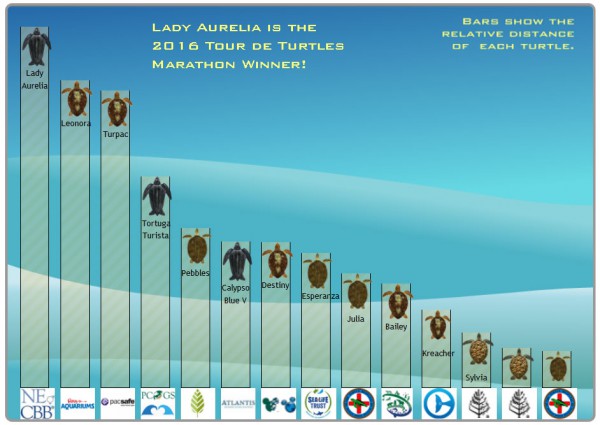
Tour de Turtles 2016 Race Results
1. Lady Aurelia = 3465 miles
2. Leonara = 2080 miles
3. Turpac = 1531 miles
4. Tortuga turista = miles
5. Pebbles = 1089 miles
6. Calypso Blue V = 1017 miles
7. Destiny = 1020 miles
8. Esperanza = 918 miles
9. Julia = 807 miles
10. Bailey = 716 miles
11. Kreacher = 557 miles
12. Sylvia = 303 miles
13. Sundrop = 163 miles
14. Fleming = 124 miles
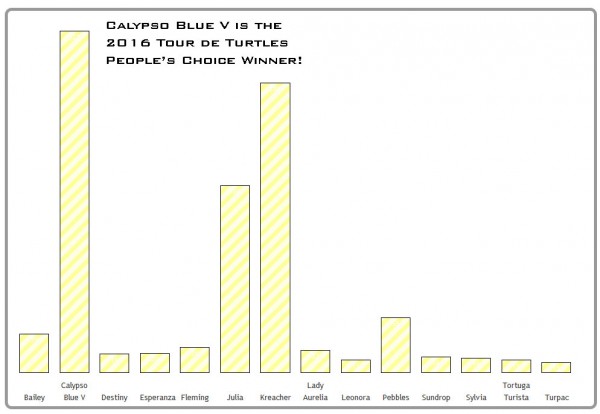 Although Lady Aurelia won in miles, we have another TDT competitor who won our hearts. And so, we are happy to announce Calypso Blue V as our 2016 People’s Choice Winner! Without the countless fans who donated and voiced their support, his victory and the tremendous progress of the other competing turtles, would not be possible. Sea Turtle Conservancy is so thankful for your support! Of course, behind every competitor is an organization that made their participation possible. Thank you to those at Atlantis for your involvement in Tour de Turtles! “Atlantis, Paradise Island is very proud to have worked with the Sea Turtle Conservancy over the last five years on Tour de Turtles” said Debra Erickson, Executive Director of the Atlantis Blue Project Foundation. “With all of the challenges that sea turtles face, Tour de Turtles provides a much-needed opportunity for school children and the public to learn more about sea turtles and how they can help save them.We are thrilled that we were able to share the adventures of Calypso Blue V with all of our supporters and that she won the People’s Choice Award.”
Although Lady Aurelia won in miles, we have another TDT competitor who won our hearts. And so, we are happy to announce Calypso Blue V as our 2016 People’s Choice Winner! Without the countless fans who donated and voiced their support, his victory and the tremendous progress of the other competing turtles, would not be possible. Sea Turtle Conservancy is so thankful for your support! Of course, behind every competitor is an organization that made their participation possible. Thank you to those at Atlantis for your involvement in Tour de Turtles! “Atlantis, Paradise Island is very proud to have worked with the Sea Turtle Conservancy over the last five years on Tour de Turtles” said Debra Erickson, Executive Director of the Atlantis Blue Project Foundation. “With all of the challenges that sea turtles face, Tour de Turtles provides a much-needed opportunity for school children and the public to learn more about sea turtles and how they can help save them.We are thrilled that we were able to share the adventures of Calypso Blue V with all of our supporters and that she won the People’s Choice Award.”
So, with an end to Tour de Turtles 2016, we want to express our gratitude once again for all the sponsors and individuals who supported the race and further, those who continually support our efforts! Sea turtle conservation is such an important cause for our world and your support does not go unnoticed.
Tour de Turtles 2016 Sponsors
| Atlantis, Paradise Island | Cuba Marine Research and Conservation Program | pacsafe |
|
Clearwater Marine Aquarium |
DivinityLA |
Ripley’s Aquariums |
|
Disney’s Animal Programs |
Four Seasons Resort Nevis |
Sea Life Trust |
|
Disney’s Vero Beach Resort |
New England Cord Blood Bank |
Shark Reef Aquarium |
|
Disney’s Conservation Fund |
Patel College of Global Sustainability |
The Turtle Hospital |
See you next year for Tour de Turtles 2017!
Sea Turtle Conservancy (STC) would like to give a special congratulations to the winners of our 2017 Sea Turtle Scenes Calendar Contest! All of the photos were truly fantastic. Thank you to everyone who took the time to enter!
The winning photographs will be featured in STC’s 2017 Sea Turtle Scenes Calendar, which will be available online in our gift shop sometime in November. Thank you to all of our participants who made this year’s selection exciting and especially difficult. We received HUNDREDS of submissions! If you missed out on this one, look out for the 2018 photography contest next year!
Here are this year’s winners:
By: Colin Davis **Cover Image!**

By: Joanie Tomlin
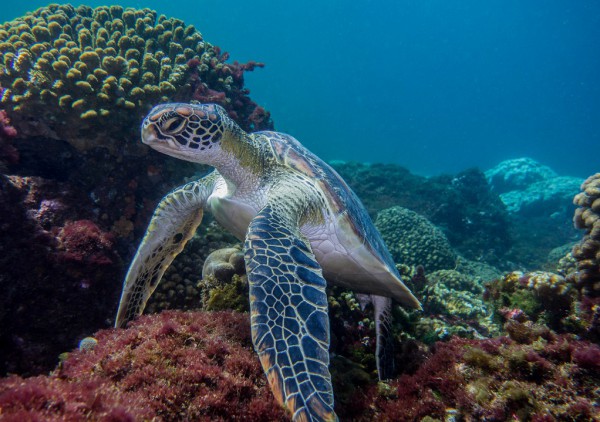
By: Karla Morales

By: Ralph Pace
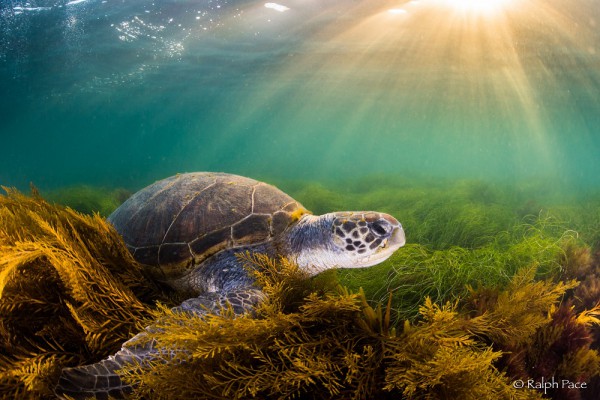
By: Spencer Sarson
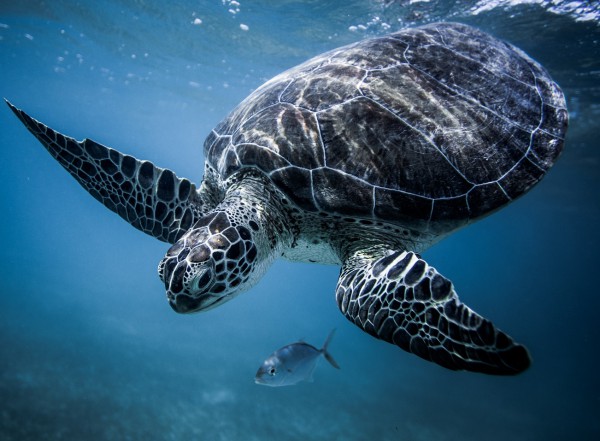
By: Staci-Lee Sherwood

By: Mario Cisneros
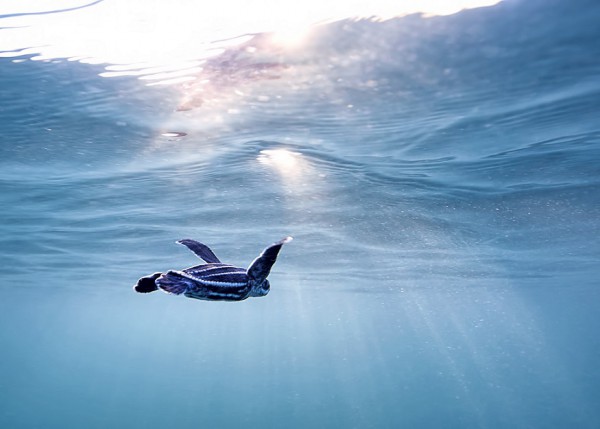
By: Colin Davis
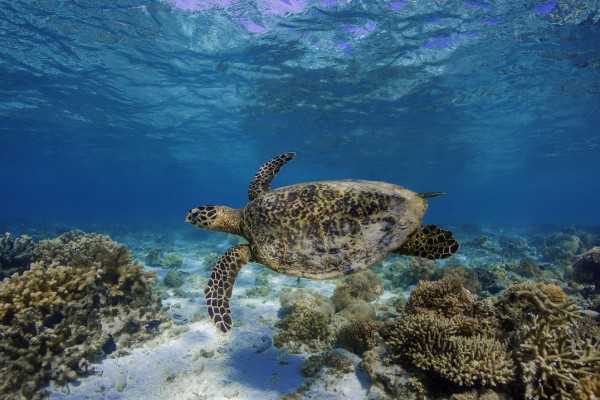
By: Ursula Dubrick

By: Ben Hicks

By: Celeste McWilliams

By: Karla G. Barrientos-Munoz
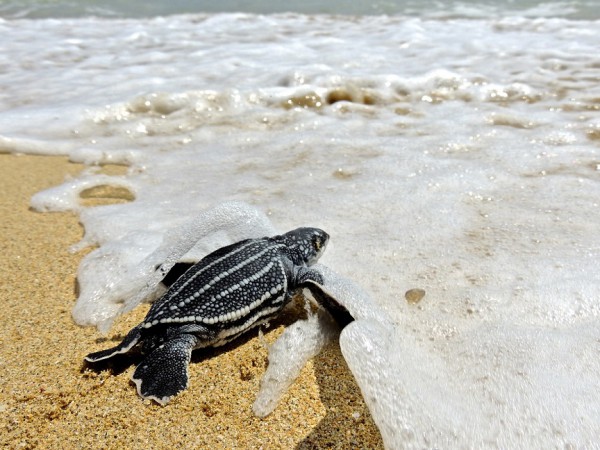
By: Mario Cisneros

By: Staci-Lee Sherwood

 Sea Turtle Conservancy (STC) is excited to officially welcome our partners at DivinityLA to the Tour de Turtles marathon! For this year’s Tour de Turtles, DivinityLA sponsored a green turtle, who they named “Pebbles.” When deciding on a name for their turtle, DivinityLA was inspired by the importance of pebbles and sand in the turtles’ nesting and hatching process.
Sea Turtle Conservancy (STC) is excited to officially welcome our partners at DivinityLA to the Tour de Turtles marathon! For this year’s Tour de Turtles, DivinityLA sponsored a green turtle, who they named “Pebbles.” When deciding on a name for their turtle, DivinityLA was inspired by the importance of pebbles and sand in the turtles’ nesting and hatching process.
To begin her migration marathon, Pebbles, a green turtle from Tortuguero, Costa Rica, was released on July 9, 2016 from STC’s John H. Phipps Biological Field Station in Tortuguero.
Since the launch of their company in 2015, DivinityLA has donated over $17,000 to Sea Turtle Conservancy- a tremendous effort that should not go unrecognized! One dollar from every sea turtle bracelet purchased is donated to STC. Click here to purchase and support sea turtles!

Pebbles is released with a satellite transmitter in Tortuguero
In addition to the incredible partnership they have with STC, DivinityLA has developed partnerships with a number of other hand-selected non-profits whose purpose supports their own mission and values. With each bracelet purchased, a portion of the proceeds is donated to one of the organizations. As DivinityLA representative Kailey Ruiz said, “In our world, we need more companies who are willing to look out for the greater good, as well as their own, and by contributing to wildlife conservation and human improvement we are playing our part as best we can.”
While they have greatly involved themselves in making a global impact through donations to  international DivinityLA turtle bracelet NEWorganizations like STC, DivinityLA also focuses on making improvements closer to home. Through meal preparation and distribution for the homeless, DivinityLA gives back to their local Los Angeles community. “We believe that any and all efforts, big or small, can have a lasting impact on all living things that surround us.”
international DivinityLA turtle bracelet NEWorganizations like STC, DivinityLA also focuses on making improvements closer to home. Through meal preparation and distribution for the homeless, DivinityLA gives back to their local Los Angeles community. “We believe that any and all efforts, big or small, can have a lasting impact on all living things that surround us.”
For DivinityLA, Tour de Turtles is the next step in expressing their loyalty to and support of sea turtle conservation. “We are very excited about the opportunity to follow these turtles on such an intimate and remarkable journey. We can’t wait to see their movement throughout the migration and anticipate the nesting of their future hatchlings!”
$1 from every sea turtle bracelet purchased is donated to STC. Click here to purchase and support sea turtles! And don’t forget to follow Pebbles on her marathon migration! You can view her satellite map online here.

This year in our race to spread awareness, Tour De Turtles has 3 BIG competitors joining us all the way from Panama. Adult leatherbacks Calypso Blue V, Lady Aurelia, and Tortuga Turista join the race to shed some light on various issues affecting the sea turtle population.
First we have Calypso Blue V who is swimming to raise awareness about the detrimental effects of commercial trawl fishing on sea turtles. More than 250,000 sea turtles are accidentally captured, harmed, or killed by fishermen in the U.S. alone each year. Trawling, which involves large nets being dragged behind one or more boats, poses such a serious threat due to its capacity to blindly catch all marine life in its path. While migrating through fishing areas, or feeding within those areas, sea turtles run the tremendous risk of being tangled within trawl nets, leading to possible injury or death. The implementation of Turtle Excluder Devices (TEDs) can reduce turtle captures by 90%, but are not currently required in non-shrimp trawl fisheries. With the incredible help from Atlantis, Paradise Island, we hope to expand the use of TEDs in all trawl fisheries and further regulate the industry.
 Our next turtle, Lady Aurelia, is sponsored by the New England Cord Blood Bank to bring attention to the issues caused by invasive species. While sea turtles have many natural predators that help regulate the natural balance of the food chain, human development has brought rise to several unnatural predators that further endanger sea turtle populations. Trash left on the beach by humans attracts raccoons, stray dogs, or other non-native species in search for food; in turn, these animals may encounter a sea turtle nest or hatchlings and decide it a sufficient food source. Raccoons destroy tens of thousands of sea turtle eggs and hatchlings a year, making it one of the greatest causes of sea turtle mortality on Florida beaches. In Central America, dogs pose the greatest threat as many coastal villages allow them to run free where they can dig up several nests in one night, or even attack a nesting turtle. This problem can be solved with just some small steps us humans!
Our next turtle, Lady Aurelia, is sponsored by the New England Cord Blood Bank to bring attention to the issues caused by invasive species. While sea turtles have many natural predators that help regulate the natural balance of the food chain, human development has brought rise to several unnatural predators that further endanger sea turtle populations. Trash left on the beach by humans attracts raccoons, stray dogs, or other non-native species in search for food; in turn, these animals may encounter a sea turtle nest or hatchlings and decide it a sufficient food source. Raccoons destroy tens of thousands of sea turtle eggs and hatchlings a year, making it one of the greatest causes of sea turtle mortality on Florida beaches. In Central America, dogs pose the greatest threat as many coastal villages allow them to run free where they can dig up several nests in one night, or even attack a nesting turtle. This problem can be solved with just some small steps us humans!
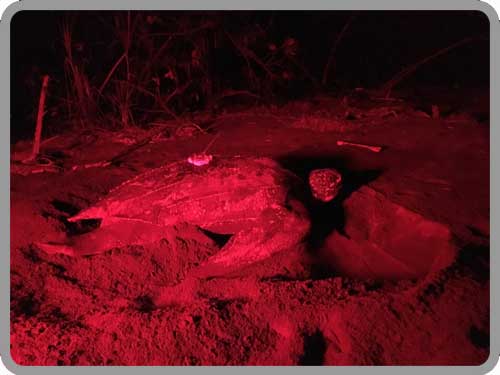 Tortuga Turista is our last leatherback sea turtle from Panama. She, along with the tremendous support from her sponsors at the USF Patel College of Global Sustainability, is joining the race to speak up about sustainable tourism. Tourism is an ever-growing industry in our increasingly globalized world. While it brings forth countless economic and social benefits, it does not come without its many environmental concerns. Of greatest concern to us, is the impact of coastal tourism on this fragile ecosystem and its multitude of wildlife, like sea turtles. Nesting habitat degradation, an increase in waste, rise in boat strikes, and an increase in illumination on beaches—which discourage possible nesting turtles— are only some of the negative impacts seen with a rise in tourism. Through education and proper planning and management, the impact can be greatly reduced.
Tortuga Turista is our last leatherback sea turtle from Panama. She, along with the tremendous support from her sponsors at the USF Patel College of Global Sustainability, is joining the race to speak up about sustainable tourism. Tourism is an ever-growing industry in our increasingly globalized world. While it brings forth countless economic and social benefits, it does not come without its many environmental concerns. Of greatest concern to us, is the impact of coastal tourism on this fragile ecosystem and its multitude of wildlife, like sea turtles. Nesting habitat degradation, an increase in waste, rise in boat strikes, and an increase in illumination on beaches—which discourage possible nesting turtles— are only some of the negative impacts seen with a rise in tourism. Through education and proper planning and management, the impact can be greatly reduced.
Join us in supporting one of these amazing turtles and their important cause! Visit www.tourdeturtles.org today to cheer for your favorite turtle!
Sea Turtle Conservancy is proud to announce the release of a new documentary about sea level rise and its implications for sea turtles and their nesting beaches in Florida. “Ahead of the Tide” (AOTT) was co-produced by STC and CAVU, a non-profit that uses flight and film to educate people about critical conservation issues. AOTT highlights the effects of sea level rise and climate change on Florida’s beaches through the stories and voices of local Floridians. The video includes interviews with scientists, coastal engineers, elected officials, coastal planners, conservation leaders, authors and activists. As part of this project STC, CAVU, and a host of conservation partners will be sponsoring a series of webinars on climate change and sea level rise in the coming months. You can learn about and sign up for these webinars at Aheadofthetide.org.
Sea level rise will have serious and long term impacts to the state’s sea turtle nesting beaches. Our hope is that this powerful film will help to serve as a Call to Action for all Floridians to demand that our elected leaders, government agencies and coastal communities begin planning for sea level rise in order to protect Florida’s most valuable asset — its natural sandy beaches — both for sea turtles and for people. The state’s beaches belong to all Floridians; they define our state.
Sea Turtle Conservancy believes many specific actions can be taken and policies implemented to reduce the impacts of sea level rise and climate change on sea turtle nesting beaches while also helping to protect our beaches and to ensure coastal resiliency. Most importantly, we have to start making smarter decisions about how we manage our beaches and where we build along the coast – and where we rebuild as the seas continue to rise. Of the hundreds of pages that make up Florida’s coastal development and beach management laws there is virtually no mention of sea level rise, despite the fact that Florida’s beaches are among the most vulnerable in the nation to changes in sea level. Many of Florida’s elected leaders still deny the realities of climate change and resist any effort to plan for its impacts. We hope this video will help raise awareness and empower citizens to demand that our elected officials take action.
Earlier this month, Sea Turtle Conservancy (STC) was contacted by turtle colleagues in Mexico who had spotted a green turtle with a satellite transmitter on her back nesting in Quintana Roo, Mexico. It was our Esperanza from Cuba! After receiving photos from Mexico, STC was able to identify Esperanza by her flipper tag number (which is unique to only her) and her satellite transmitter.

Esperanza nesting in Mexico
This discovery is very important because it helps confirm a pattern our partners with the Cuban Marine Turtle Conservation Program have been observing recently based on flipper tags and genetics. It was the same area where they had seen several previous nesters from Cuba go.
But wait…
What are sea turtles that nested in CUBA doing nesting in MEXICO?? This is very unusual, and it suggests that sea turtles may not be as loyal to one beach as we thought! Most females return faithfully to the same beach each time they are ready to nest. Not only do they appear on the same beach, they often emerge within a few hundred yards of where they last nested!
One of the benefits of using satellite transmitters to track sea turtles is that it helps us determine turtles’ nesting site fidelity. Or in this case, lack of fidelity.
We will continue to watch Esperanza closely over these next few months and so can you! As part of the Tour de Turtles program, you can visit Esperanza’s tracking map to see where she travels next! /trackingmap.php?id=144
Esperanza is a beautiful adult green sea turtle who was released with a satellite transmitter after nesting in Guanahacabibes Natural Park, Cuba on June 29, 2016. This turtle mama laid 152 eggs! She measured 107 cm in curved carapace (shell) length and 93 cm in curved carapace width. Esperanza, which means “hope in Spanish,” was named by her sponsors at SEA LIFE Trust and is participating in the 2016 Tour de Turtles migration marathon.

Screenshot of Esperanza’s tracking map.
To learn more about Esperanza and the rest of our Tour de Turtles competitors, visit www.TourdeTurtles.org
Kashmir World Foundation (KwF), in collaboration with Sea Turtle Conservancy and Brevard County, Florida, will be conducting a 3-day hands-on workshop on the design, fabrication and operation of programmable multi-copters for use in environmental monitoring. The workshop will assist you in creating a basic platform to evaluate a variety of unmanned aerial systems (UAS) for diverse habitats and environments while providing the expertise you need to build, maintain, and fly your drone.
http://www.kashmirworldfoundation.org/#!bic/cslv
To download event flyer: FlyForConservation

![]()

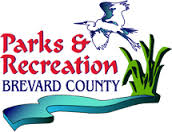
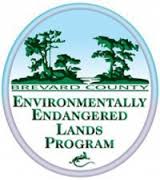
Sea Turtle Conservancy (STC) announces a change in the scientific oversight of its international sea turtle research and monitoring programs. Effective in July, the position of Scientific Director will transition from Dr. Emma Harrison to Dr. Roldán Valverde. Anyone interested in collaborating with STC on research projects in Costa Rica, Panama and other international sites are encouraged to reach out directly to Dr. Valverde at roldan@conserveturtles.org. Likewise, anyone interested in exploring opportunities to serve as a Research Assistant with the Tortuguero program or at STC’s project sites in Panama can now direct those inquires to Roldán.

Dr. Harrison with nesting turtle
While STC is very excited about what Dr. Valverde will bring to this position, the organization is equally sad to announce the departure of Dr. Emma Harrison, who has resigned to explore new opportunities in the field of biological conservation. Dr. Harrison has worked with STC off and on since 1998 and has served as Scientific Director since 2006. Through her leadership and passion, Dr. Harrison continued a long tradition of outstanding scientific oversight of STC’s sea turtle monitoring programs; she trained and inspired countless research assistants and helped expand STC’s education and community outreach programs in both Costa Rica and Panama. Emma will be greatly missed by STC, though she will forever remain a part of the STC family and the history of the organization.
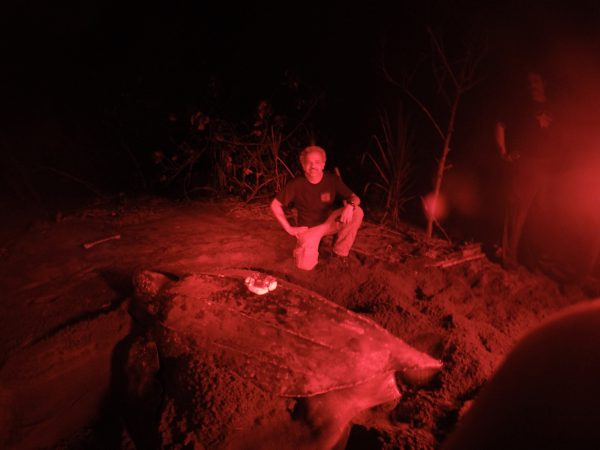
New STC scientific director Dr. Valverde with tagged leatherback
As STC’s incoming Scientific Director, Dr. Valverde will provide scientific oversight of STC’s various sea turtle research programs, particularly the long-term projects in Tortuguero, Costa Rica, and Bocas del Toro, Panama. Over two decades ago, as a young Costa Rican biologist, Roldán served as Research Coordinator of STC’s Tortuguero research program. Since that time, he has achieved international recognition in the field of sea turtle research and is a leading expert in the area of sea turtle physiology. Dr. Valverde served recently as President of the International Sea Turtle Society; he is well published; and he currently serves as a graduate biology professor at Southeast Louisiana University in New Orleans. As a native Costa Rican and an accomplished scientist and educator, Roldán will be in an ideal position to continue elevating the science and the effectiveness of STC’s many research and conservation programs. He also will help STC expand its efforts to cultivate and train young biologists from throughout Latin America and the Caribbean. Dr. Valverde’s position with STC is endowed by the Emily T. Clay Scientific Director’s Endowment.